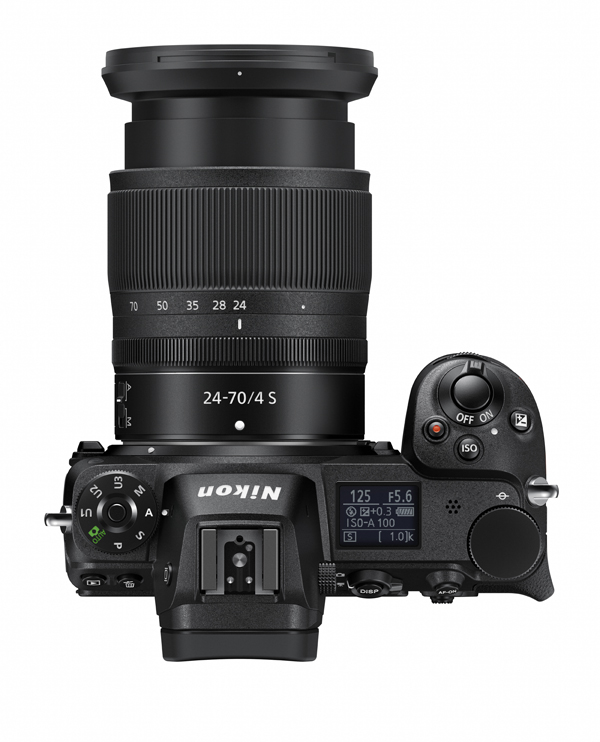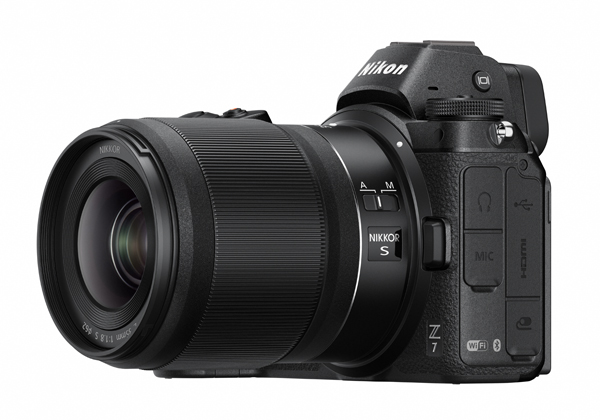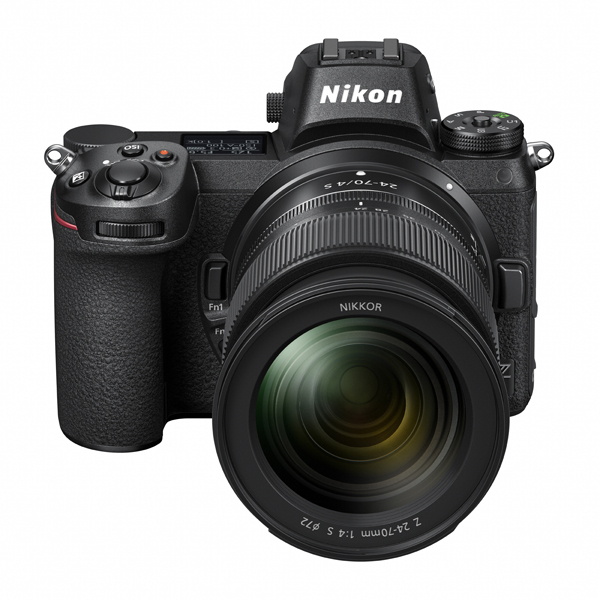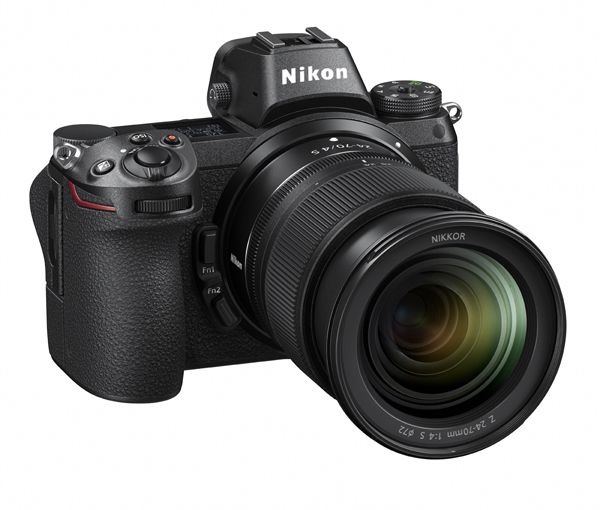The Nikon Z7 & Nikon Z6
Nikon Full-Frame Mirrorless Part 1: Everything You Need to Know About The Nikon Z7 & Nikon Z6

Nikon’s full-frame (FX format) mirrorless cameras and lenses are finally here, and there’s a lot to cover, so grab a drink and buckle up. Nikon’s launching not one, but two full-frame mirrorless camera bodies this fall. Much like the D850 vs D750 hierarchy (or the Sony A7R III vs A7 III), the 45.7-megapixel Nikon Z7 will be a pricier, higher-resolution camera, while the 24.5-megapixel Nikon Z6 will be more affordable, a little bit faster, and (possibly) better for video.
Sony’s first true market competition, the Nikon Z mount system is lighter and more compact than its DSLR ancestors, but still very much Nikon in form and function. Same menu systems, familiar button layouts, a deep ergonomical grip, and D850 levels of rugged construction and weather-sealing. In other words, Z may well be Nikon’s future, but this new ecosystem stands proudly atop a century of tradition.
We’ll be testing out the new Z gear this week in New York and Tokyo, so stay tuned for our first hands-on impressions and reviews, but let’s first dive into Nikon Z with everything you need to know about the Nikon Z7 & Z6, the four announced Z mount system lenses, and the optional FTZ Adapter.
Z Mount vs F Mount

Measuring 55mm across, the all-new Z mount is 17% wider than the F mount and, without a mirror to eating up space, features a 65% slimmer flange-mount distance (the distance between the mount and the image sensor). This means the Z mount is capable of gathering over 100% more light than the full-frame F mount, which has allowed Nikon engineers to create new lens designs, making them lighter, faster, and sharper than ever with little to no chromatic aberration.
In short, NIKKOR Z lenses will be the best Nikon lenses ever made.
But if you’re a long-time Nikon customer looking to jump to mirrorless, Nikon has you covered too, with the Mount Adapter FTZ, which will allow you to use 360 legacy F Mount lenses dating all the way back to 1959. More importantly, 93 AF-P, AF-S, and AF-I F mount lenses with built-in motors will be fully functional on the Z mount cameras (full list HERE).
For a full breakdown of the new NIKKOR Z lenses & the Mount Adapter FTZ, please… Click HERE for Part 2.
Twinsies: Nikon Z7 vs Nikon Z6

Visually speaking, the only way to tell a Nikon Z7 from a Nikon Z6 is to look for the small badge on the front of each camera. Further, most features, capabilities, button layouts, menus, build-quality, and dimensions are all the same (both weigh about one half-pound less than a D850, while shaving off nearly an inch of depth and a half-inch of width). But there are a few key differences:
- Resolution: the Z7 boasts a 45.7-megapixels compared to the Z6’s 24.5-megapixels.
- OLPF: the Z6 features an Optical Low Pass Filter on its sensor where the Z7 does not.
- ISO Range: The Z7 covers ISO 64-25600 while the Z6 hits ISO 100-51200.
- AutoFocus Points: While both the Z7 and 76 offer a hybrid AF system that covers 90% of each respective sensor, the Z7 boasts 493 AF points, while the Z6 features 273 AF points.
- Burst Shooting: The Z6 is faster, capable of shooting up to 12fps, compared to the Z7’s 9fps.
- Full Pixel Readout 4K Video: The Z6 shoots full-frame 4K video with full pixel readout while the Z7 downsamples full-frame 4K video. For full pixel readout on the Z7, you must engage DX (crop) mode.
- Time-Lapse Resolution: Both the Z7 and Z6 include an interval photography timer, but the Z7’s higher resolution means you can use the camera to create 8K resolution time-lapses (using 3rd party software).
- Battery Charger: Only the Z7 will include the EH-7P Charging AC Adapter
- Pricing: The Z7 will MSRP for $1400 more than the Z6.
New Sensors & Image Processing Engine

While the Z7 and Z6 share similarities with the D850 and D750, respectively, both cameras feature new Nikon-designed BSI (backside illuminated) CMOS image sensors with built-in focal-plane phase-detection AF pixels (a first for Nikon), and the new EXPEED 6 image processing engine.
The Z7’s 45.7MP sensor lacks an OPLF, for extra crispy landscape & astrophotography, and Nikon claims both cameras will produce clean, sharp still photos and videos with less noise at higher ISOs than ever before. There are also new mid-range sharpening tools and 20 adjustable Creative Picture Control options to play with. As mentioned above, the Z7 matches the D850’s ISO 64-25600 range (DXO Mark lists the D850’s sensor as the third best sensor on the market), while the 24.5MP Z6 sensor is good for ISO 100-51200.
Hybrid AF with 90% Sensor Coverage
The Nikon Z7 boasts a 493-point hybrid AF system (up from 399-point system on the Sony A7R III) while the Z6 features a 273-point hybrid AF system (down from the 693-point systems on the Sony A7 III & A9). For those less familiar, hybrid AF uses a combination of focal-plane phase-detection AF and contrast-detect AF to achieve quick, quiet, sharp focus on still and moving subjects. Aside from the brand competition, this is exciting because it means a pro-level Nikon camera will finally feature useable AutoFocus during video recording. You can expect to see familiar Nikon modes like Auto Area AF, Subject Tracking, and Predictive AF.
5-Axis Vibration Reduction
Another long-overdue first for Nikon. With 5-Axis VR (Vibration Reduction) correcting for pitch, yaw, and x/y/z-axis roll, the Nikon Z7 or Z6 with a NIKKOR Z lens achieves up to 5.0 stops of exposure compensation, helping to keep your images sharper at slower shutter speeds and/or helping you use lower ISO settings. It should also help out with handheld videos, but, typically, full-frame image stabilization is less effective than for smaller crop-sensor systems, so you probably still need a gimbal for smooth video.
Nikon also claims the Z7 and Z6 will maintain 5-axis VR using the optional Mount Adapter FTZ with certain VR-equipped F mount lenses. In these scenarios, VR-equipped F mount lenses handle pitch and yaw, while the cameras tackle x/y/z roll. Where an F mount lens is NOT VR-capable, the Z7 and Z6 will still offer 3-axis in-camera VR.
The Best Nikon Video Camera… Ever!

For anyone familiar with the D850, the Nikon Z7 and Z6’s video capabilities are going to feel very familiar, but there are a few key upgrades aimed squarely at pros. The Z7 and Z6 top out at 4K UHD (3840 × 2160) 30p recording (no 4K/60p) like the D850, but the Z7 and Z6 will be Nikon’s first cameras to offer 10-bit 4:2:2 4K video recording along with the N-log color profile, which boosts dynamic range to 12 stops for HDR grading and improved color. The catch? You can only shoot 10-bit via the cameras’ HDMI outputs, recording to an external drive. If you want to record internally, you’re limited to 8-bit 4:2:0 4K.
The Z7 and Z6 also best the D850’s slow-mo capabilities; where the D850 is limited to a 120fps / 5x “Slow Motion” mode — which over-cranks the video and produces an average-looking 24p movie file — the Z7 and Z6, conversely, are capable of true 1080/120p. Much like the Sony cameras, the resulting 120p footage, when slowed in post, should be smoother and more detailed compared to D850 slow motion.
Other video improvements and features include built-in timecode well as Active D-Lighting, electronic vibration reduction, and focus peaking for both 4K & HD (the D850 is limited to HD-only).
As noted above, both Z cameras shoot full-frame (FX mode) 4K video, but with fewer pixels on its sensor, the Z6 shoots full frame with full pixel readout (no downsampling, less moire) and should producer cleaner footage. The Z7, conversely, shoots 4K video with full pixel readout in its DX (crop) mode, meaning it’s not full-frame video and all of your lens focal lengths will be magnified by 1.5x. In FX (full-frame) mode, the Z7 uses some form of downsampling. Will it make much of a difference? We don’t know yet, but we’ll write more about this as soon as we get our hands on both cameras and see the footage for ourselves.
Regardless, with 10-bit 4K, true 120p slow motion, timecode, N-log, in-camera/electronic vibration reduction, and a new hybrid AF system, the Nikon Z7 and Z6 are poised to be the best Nikon video cameras ever.
RAW, Silent, Speed
Both Z mount system cameras offer a silent mode (electronic shutter) and capture still images in jpeg, 12-bit lossless RAW, or 14-bit uncompressed RAW files. Also, both can shoot up to 18 14-bit RAW files, up to 23 12-bit RAW files, or up to (25 Fine Large) jpeg files in a single go. With less pixels on the sensor, the Z6 is faster, shooting up to 12fps, while the Z7 can shoot up to 9fps. Both of these figures, as well as the number of potential images capture, vary at times. For example, Silent Mode drops performance by about 1fps, as does shooting 14-bit RAW. However, Nikon is developing the MB-N10 Multi-Power Battery Pack, which will boost performance by as much as 1.8x (more on this below).
Screen Trio

The Z7 and Z6 both feature a new 3.6M dot QVGA EVF with an OLED screen, .8x magnification (great for eyeglass wearers), and 100% frame coverage. You can also use the EVF to shoot and review movies (not just stills). There’s also a top deck OLED matrix LCD panel, to keep track of settings, as well as 3.2″ tilting touchscreen (from the D850) for framing shots, reviewing images, and easily navigating the cameras’ menu systems (it’s leagues better than Sony menus). Speaking of which, the Z7 and Z6 menus are very similar to anyone who’s used a Nikon DSLR lately, but they have improved the Custom Settings grid, allowing you to customize up to 30 different settings.
Rugged & Ergonomic

Quite simply, the Nikon Z7 and Z6 are built as tough as the D850.
The body is magnesium alloy. It’s weather-sealed up the wazoo with rubber o-rings (so are the new lenses). And the mechanical shutter’s been tested for up to 200,000 cycles. And, most importantly, Nikon has elected to keep it’s easy-to-hold deep grip and familiar button layouts. If you’re a longtime Nikon customer, the Z7 and Z6 are going to make you feel at home; if you’re new to Nikon, you’re going to love holding the Z mount cameras in your hand for hours without any fatigue (so many mirrorless systems are too small in the grip department.
There’s No SD Card Slot
Unlike the D850, which offers both XQD and SD UHS-II dual card slots OR Sony’s dual SD card slots, the Nikon Z7 and Z6 bodies offer one, lonely memory card slot and it doesn’t hold standard SD memory cards. Instead, Nikon’s opted for an XQD only approach (it will also support CFexpress (CFX) after a future firmware update). The great news is that XQD cards offer much more performance than even the fastest SD cards, but the bad news is that they are more expensive to buy and, without a dual-card system, you won’t be able to build redundancy into your workflow (a smart idea for wedding photographers).
Improved Wireless Connectivity
Much like the D850 and other pro-level Nikon DSLRs, the Z7 is compatible with all Nikon accessories, including the company’s speed lights / flashes, remotes, microphones, and so on. The Z7 also supports SnapBridge 2.5 via Wi-Fi & Bluetooth, is PC-ready (for RAW, JPEG, TIFF, & Video transfer to computers), and boasts pro support via the WT-7/A/B/C Wireless Transmitter (available separately) just like the D850 and D5. So it’s ready for pro environments.
New Battery / Old Batteries: Bring Them All
The Nikon Z Series cameras feature Nikon’s EN-EL15B battery. This B variety has been adapted so you can charge it via a charger (included with the Z7, optional with the Z6) OR in-camera via USB. Adding to the flexibility, if you already own an EN-EL15A battery, you can also use those in Z Series cameras and there’s no performance loss. However, the A-version batteries can’t be charged in-camera via USB. Lastly, you can also use the original EN-EL15 batteries in the Z Series, but they won’t last as long or offer the same high-speed performance of the B & A iterations.
As previously mentioned, Nikon has announced the development of the MB-N10 Multi-Power Battery Pack, which will hold two EN-EL15B batteries, boosting movie recording by up to 1.8x, improving high-speed burst shooting, and adding to the number of images you can capture in one burst. It should also serve as a nice grip for portrait photographers or anyone shooting vertically. It too will support USB-charging.

Specs & Accessories
Exclusive Z7 Features
- 45.7MP BSI CMOS image sensor with on-sensor phase detection
- No Optical Low Pass Filter (OLPF)
- ISO 64-25600
- Expandable to ISO 32-102400
- 9fps high-speed continuous shooting (extended)
- 493-point AF
- DX (crop) mode 4K video recording with full pixel readout
- 8K Time-lapses with the Interval Timer
Exclusive Z6 Features
- 24.5MP BSI CMOS image sensor with on-sensor phase detection
- OLPF (Optical Low Pass Filter)
- ISO 100-51200
- Expandable to ISO 50-204800
- 12fps high-speed continuous shooting (extended)
- Full-frame 4K video recording with full pixel readout
- 273-point AF
Z7 & Z6 Shared Features
- Compatible Lenses: Z mount (native); F mount (with optional adapter)
- EXPEED 6 Image Processor
- Hybrid AF system
- covers 90% of the sensor vertically & horizontally
- switches between focal-plane phase-detection AF and contrast-detect AF
- 3.6M dot QVGA EVF (OLED)
- 100% frame coverage and 0.8× magnification
- 3.2″ tilting touchscreen LCD (out of the D850)
- 5-Axis Vibration Reduction
- Up to 5.0 stops of exposure compensation
- 4K UHD (3840 × 2160)/30p
- 10-bit 4:2:2 4K video when using the HDMI out
- N-log color profile boosts dynamic range to 12 stops
- 8-bit 4:2:0 4K video recording internal or external
- Full-HD/120p slow motion
- Active D-Lighting
- electronic vibration reduction
- focus peaking (for 4K & HD)
- Silent shooting mode
- 12-bit lossless RAW
- 14-bit uncompressed RAW
- Interval timer photography (HD or 4K Time Lapse Movie mode)
- Memory Card Slots
- XQD & UHS-II out of the box
- The XQD slot is getting a CFexpress firmware update after release
- Similar Menu to previous Nikon camera, but with a revised Custom Settings grid (customize up to 30 settings)
- D850-levels of ruggedness in a smaller body
- magnesium alloy body
- weather sealing
- shutter rated for 200K cycles
- Snapbridge 2.5
- WiFi & Bluetooth
- Snapbridge 2.5
- PC transfer (RAW, JPEG, TIFF, Video to computer)
- Dimensions: 5.3 × 4 × 2.7 in. (134 × 100.5 × 67.5 mm)
- Weight (with battery & memory card): 1 lb 7.9 oz (23.9 oz or 675 g)
- Support for existing (optional) DSLR camera accessories
- Supports EN-EL15/a/b batteries
Optional Accessories
- Mounter Adapter FTZ
- 360 NIKKOR F mount lens dating back to 1959
- 90 retain full or improved functionality, including AF, aperture, white balance, and VR
- MB-N10 Multi-Power Battery Pack
- Holds two EN-EL15b batteries
- Boosts high-speed continuous shooting, movie recording time, and number of still images you can capture
- WT-7/A/B/C Wireless Transmitter
- Nikon Speed Lights & Radio Controllers
Pricing & Availability
The Nikon Z7 mirrorless camera will be available September 27, 2018, in two forms:
- Body-only for $3399.95
- Z7 + NIKKOR Z 24-70 F4 S kit for $3999.95 (a savings of $400 when buying separately)
The Nikon Z6 will be available in late November 2018 in two forms:
- Body-only for $1995.95
- Z6 + NIKKOR Z 24-70 F4 S kit for $2599.95 (a savings of $400 when buying separately)
The Mount Adapter FTZ will also be available September 27, 2018, for $249.95. But if you buy the adapter before December 31, 2018, and at the same time as a Z7 or Z6 camera system, you’ll be able to snag it for $150.
Click HERE for Part 2 (where we break down all the new NIKKOR Z lenses and FTZ Adapter)




August 26, 2018 at 10:47 am, DaveAms said:
Too little, too late, too expensive.
August 26, 2018 at 2:23 am, Artclassics said:
Could you pls check on your test the silent mode at various speeds in various artificial lights. Mayby Nikon has not the banding problem then the SONY still has
August 25, 2018 at 12:55 pm, Bill Townsend said:
The lack of dual SD slots is a sad feature loss. This feature has saved me a couple times.